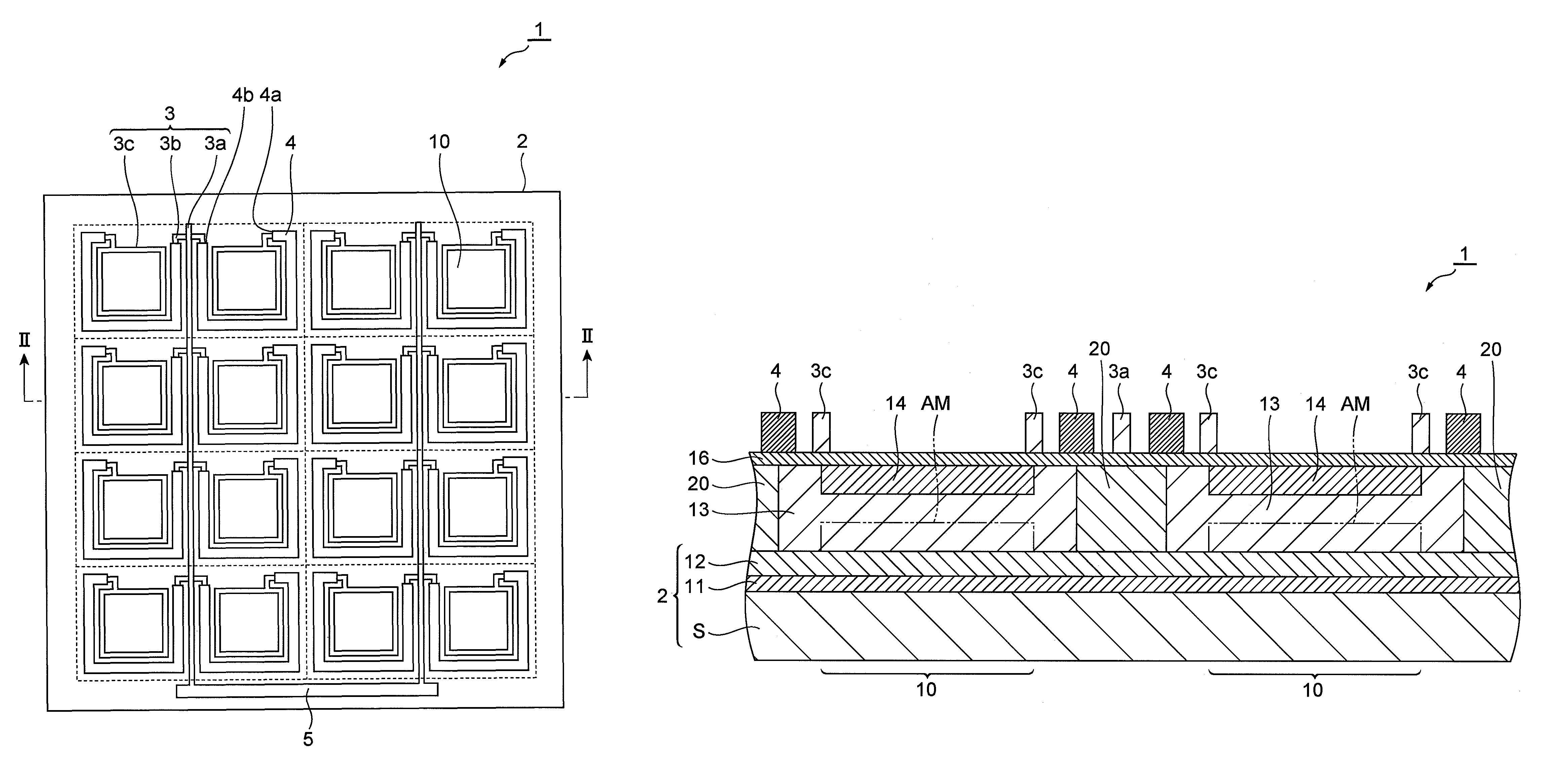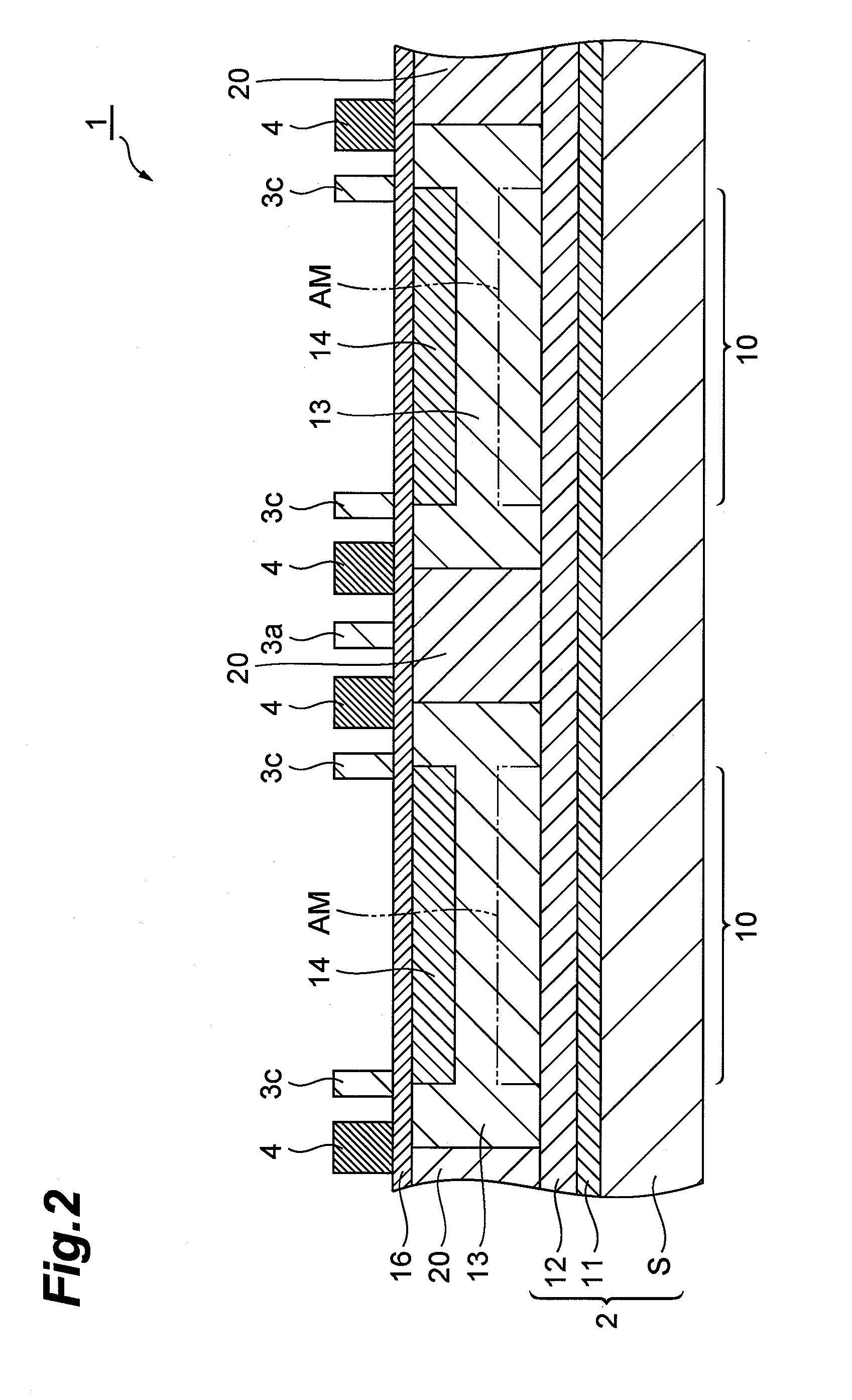Photodiode array
a technology of photodiodes and arrays, applied in the field of photodiodes, can solve the problems of hardly improving detection sensitivity, and achieve the effect of high ratio of opening area
- Summary
- Abstract
- Description
- Claims
- Application Information
AI Technical Summary
Benefits of technology
Problems solved by technology
Method used
Image
Examples
first embodiment
[0054]With reference to FIG. 1 and FIG. 2, the configuration of a photodiode array 1 according to a first embodiment will be explained below. FIG. 1 is a view schematically showing an upper surface of the photodiode array 1 according to a first embodiment. FIG. 2 is a view showing a part of the cross section taken along the line II-II of the photodiode array 1 according to the first embodiment.
[0055]The photodiode array 1 is formed with a plurality of semiconductor layers and an insulating layer laminated to a substrate 2. As shown in FIG. 1, the photodiode array 1 is a multichannel avalanche photodiode for photon counting having a plurality of photodetector channels 10 formed in a matrix (4×4 in the present embodiment) to which a light to be detected is incident. The photodiode array 1 has a signal conductor 3, resistors 4, and an electrode pad 5 on the upper surface thereof. The substrate 2 is a square with a side of about 1 mm, for example. Each of the photodetector channels 10 i...
second embodiment
[0077]With reference to FIG. 6, the configuration of a photodiode array 30 according to a second embodiment will be explained below. FIG. 6 is a view schematically illustrating the cross sectional structure of the photodiode array 30 according to the second embodiment. The photodiode array 30 according to the third embodiment is similar to the photodiode array 1 according to the first embodiment except that the separating part 20 has a light shielding part.
[0078]As shown in FIG. 6, the separating parts 20 comprises a light shielding part 22 formed of a material which absorbs a light of a wavelength band (from invisible to near infrared) which is to be detected by the photodetector channel 10. The light shielding part 22 is formed to be embedded in the separating part 20 like a core extending from the upper surface side to the lower surface side of the p−-type semiconductor layer 13. The light shielding part 22 is formed of a metal such as black photo-resist which is obtained by mixi...
third embodiment
[0088]With reference to FIG. 7, the configuration of a photodiode array 40 according to a third embodiment will be explained below. FIG. 7 is a view schematically illustrating the cross sectional structure of the photodiode array 40 according to a third embodiment. The photodiode array 40 according to the third embodiment is similar to the photodiode array 1 according to the first embodiment except that the signal conductor 3 is formed on a silicon nitride film.
[0089]As shown in FIG. 7, the photodiode array 40 comprises the substrate 2 having a semiconductor layer of n-type (a first conductivity type), the p-type semiconductor layer 15 of p-type (a second conductivity type) which is formed on the substrate 2, the p+-type semiconductor layer 14 of p-type which is formed on the p-type semiconductor layer 15, protective films 16a and 16b, the separating part 20 of n-type (the first conductivity type) formed on the p-type semiconductor layer 15, the signal conductor 3 formed of aluminum...
PUM
 Login to View More
Login to View More Abstract
Description
Claims
Application Information
 Login to View More
Login to View More - R&D
- Intellectual Property
- Life Sciences
- Materials
- Tech Scout
- Unparalleled Data Quality
- Higher Quality Content
- 60% Fewer Hallucinations
Browse by: Latest US Patents, China's latest patents, Technical Efficacy Thesaurus, Application Domain, Technology Topic, Popular Technical Reports.
© 2025 PatSnap. All rights reserved.Legal|Privacy policy|Modern Slavery Act Transparency Statement|Sitemap|About US| Contact US: help@patsnap.com



